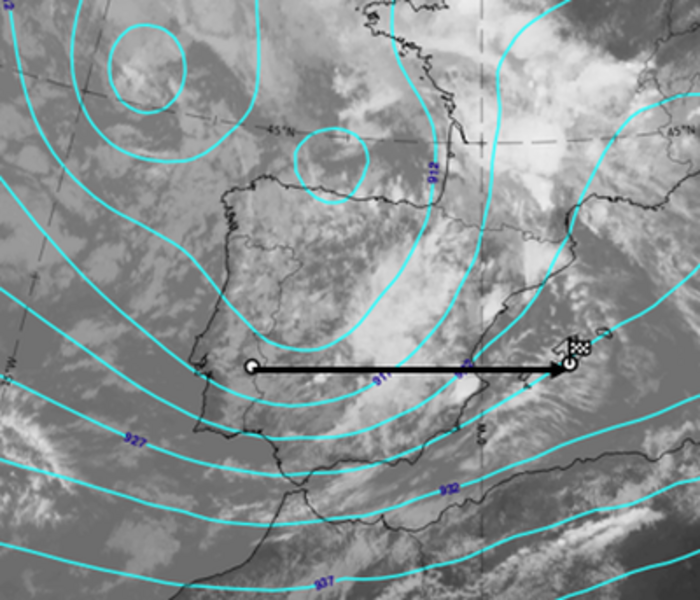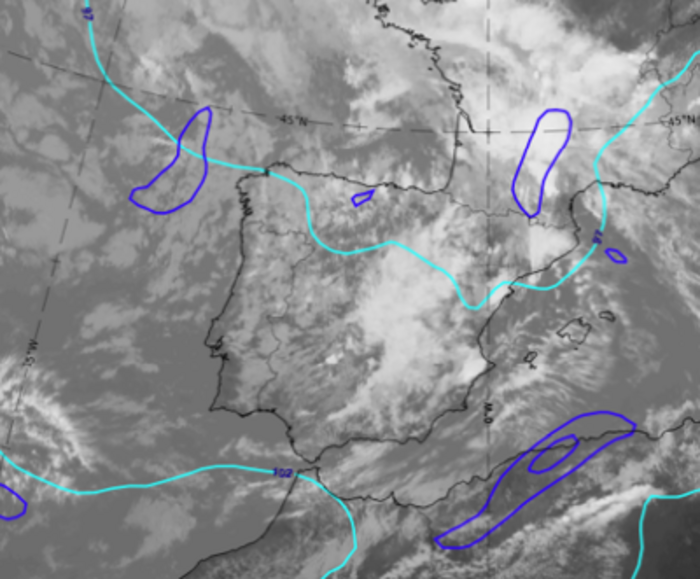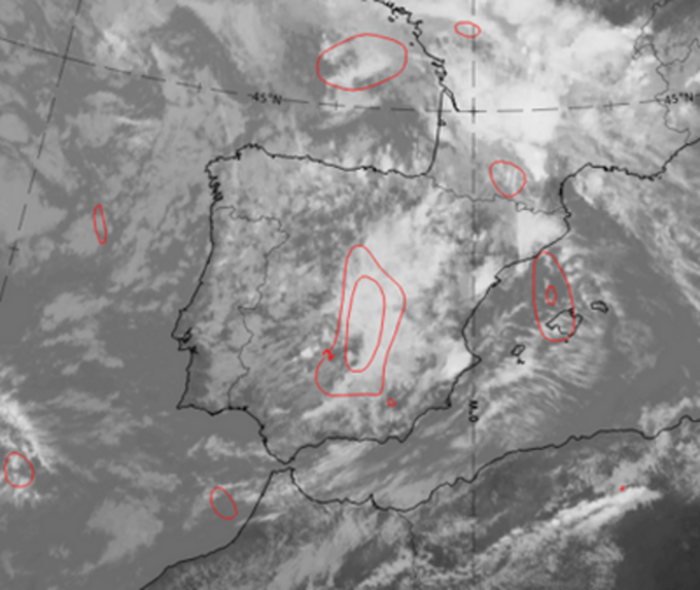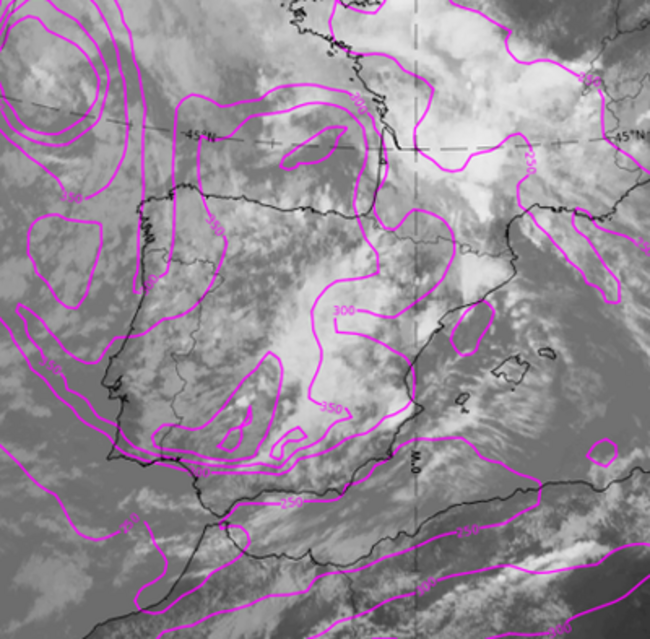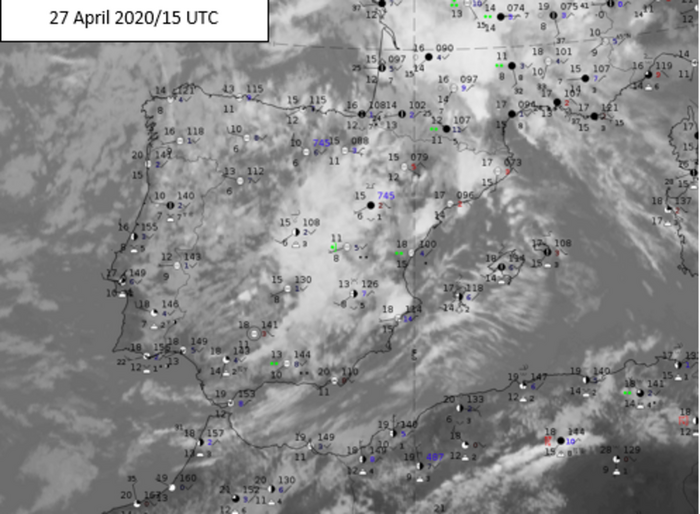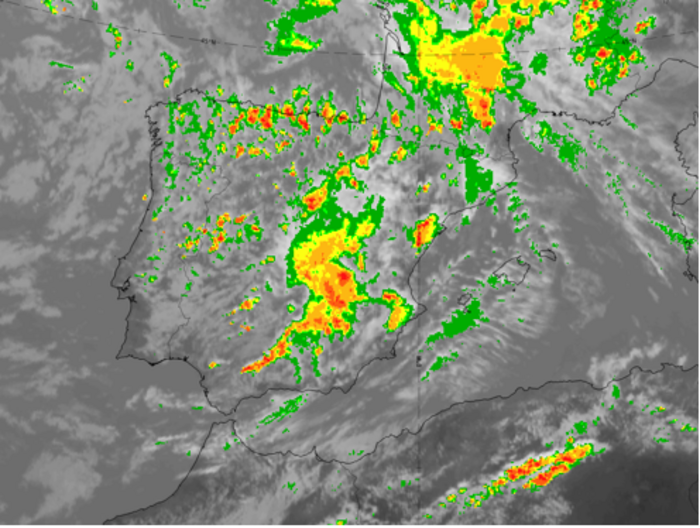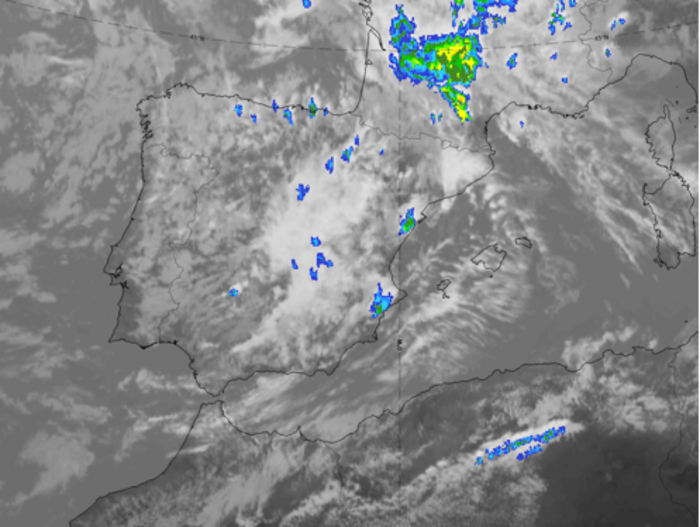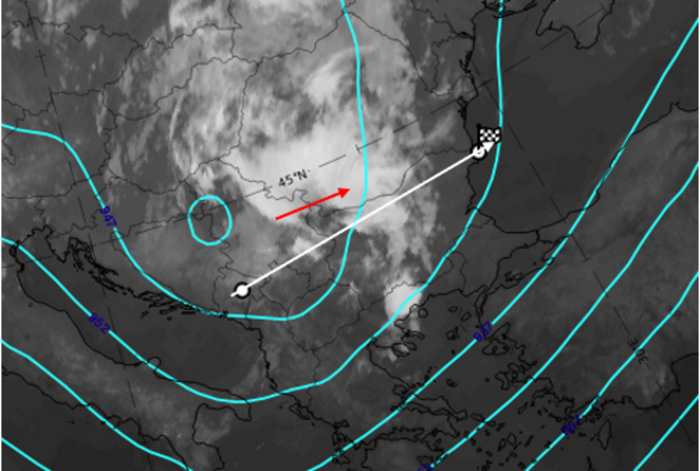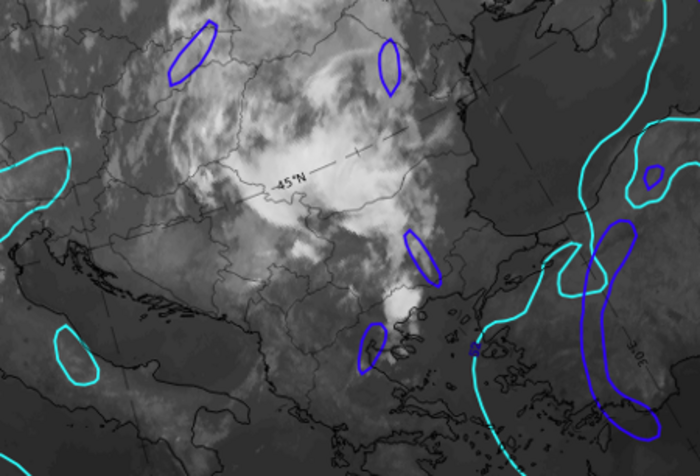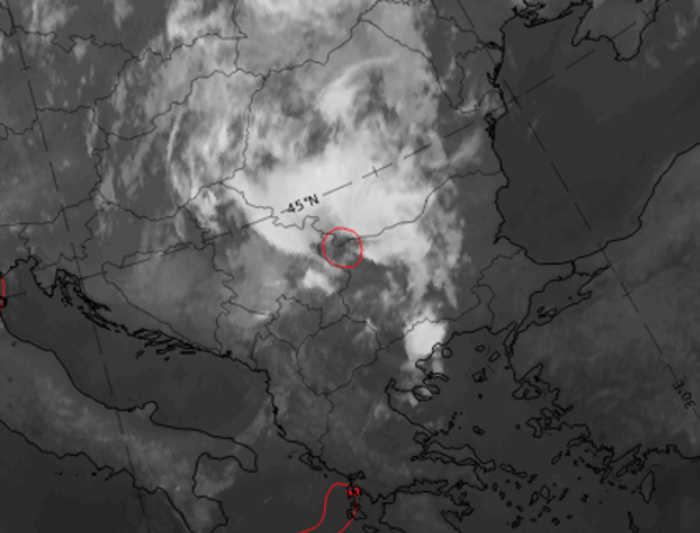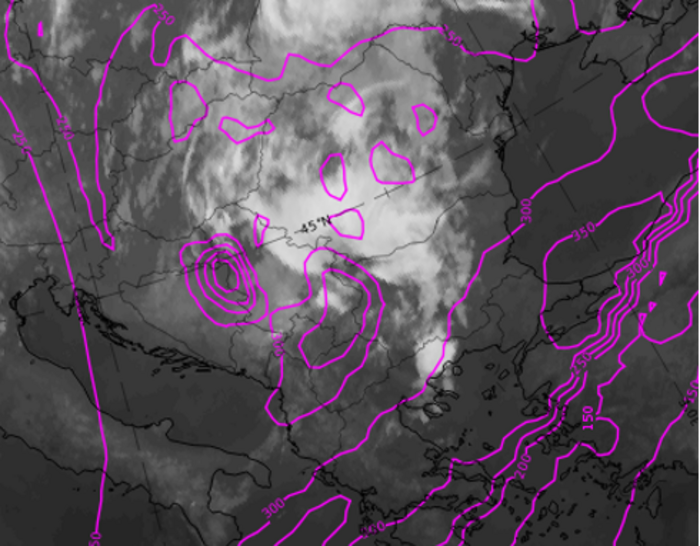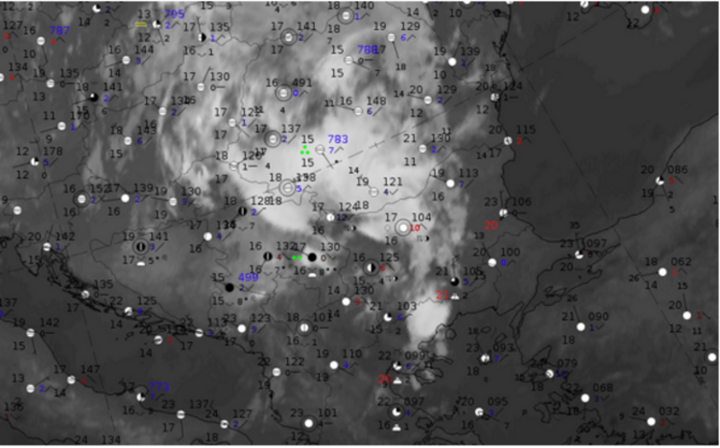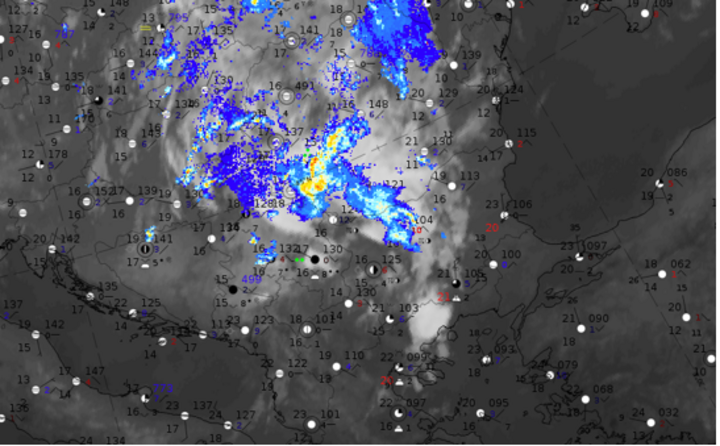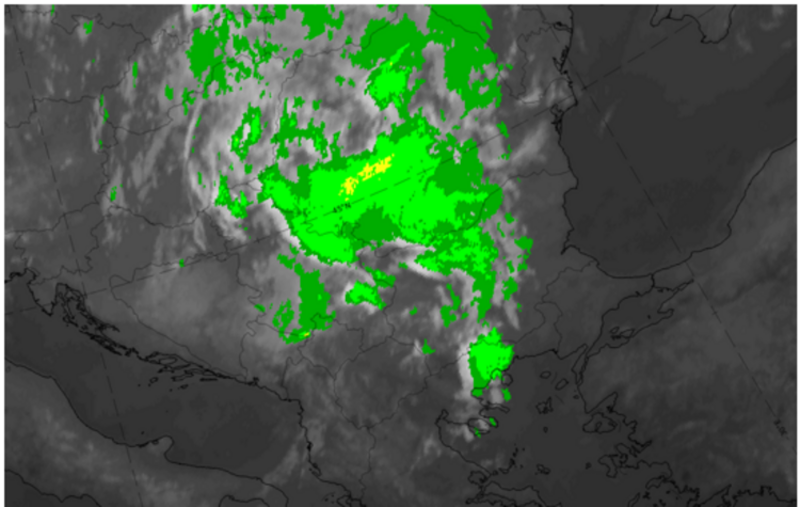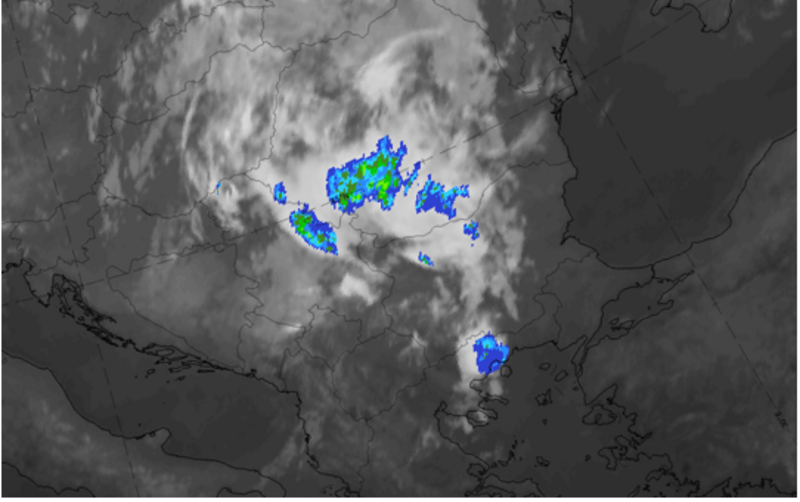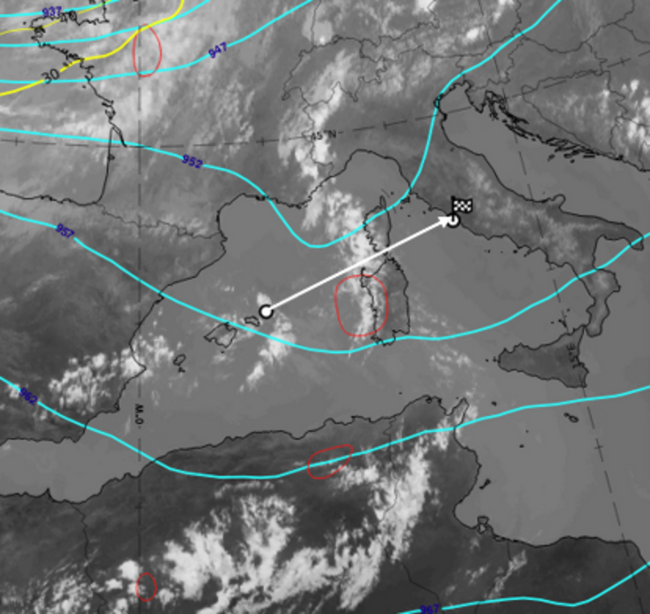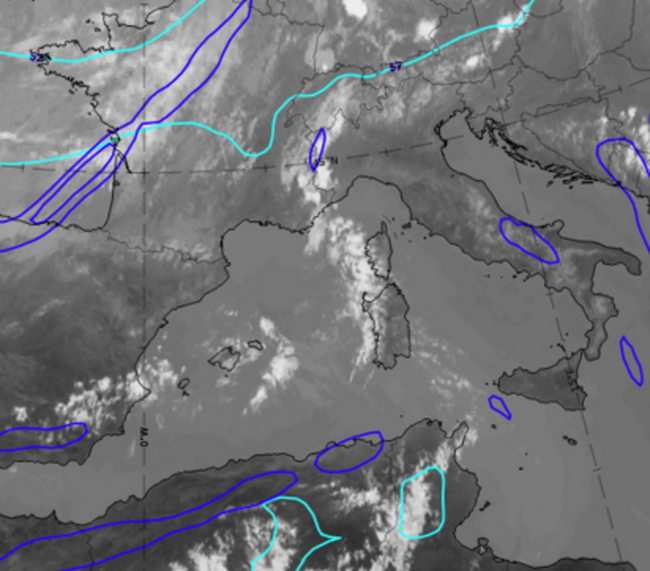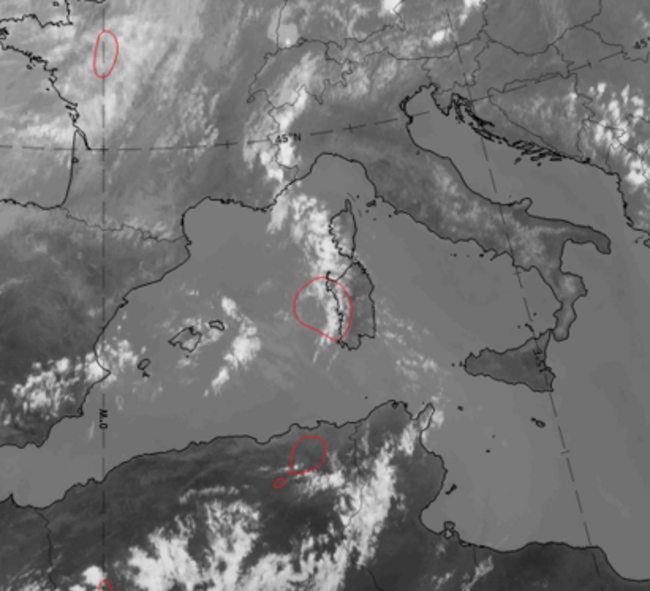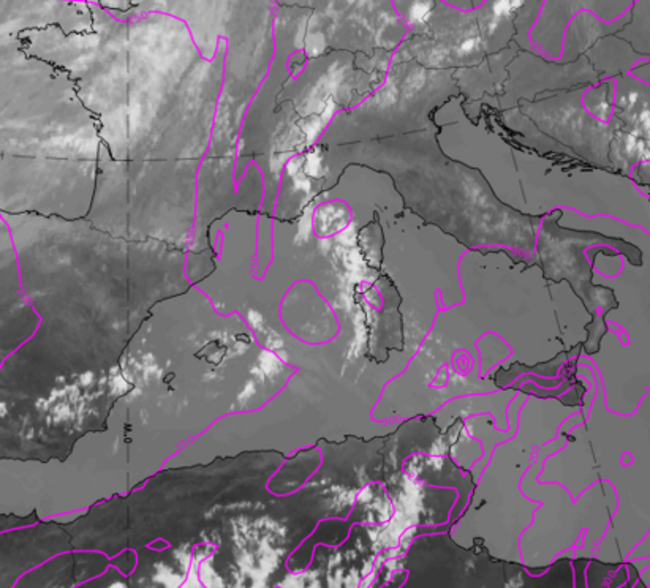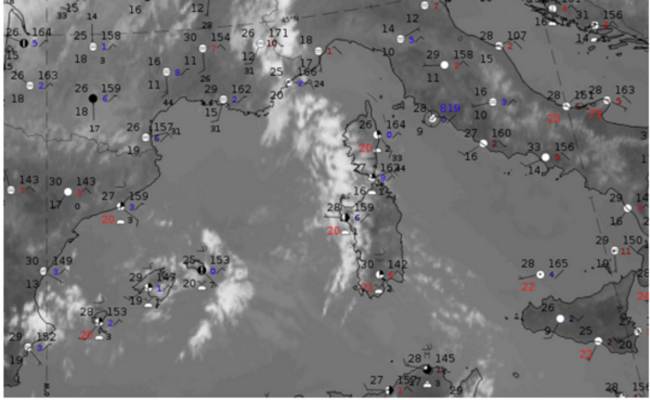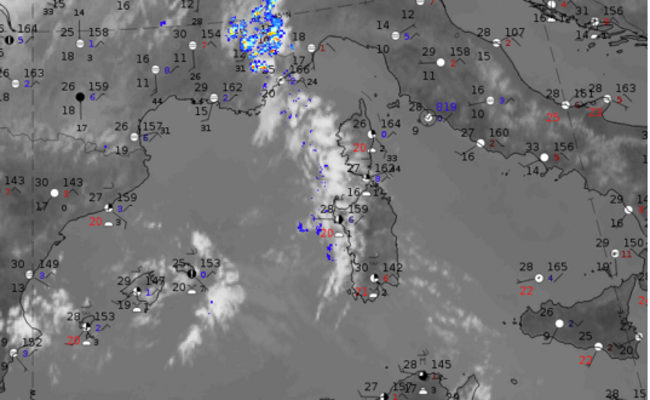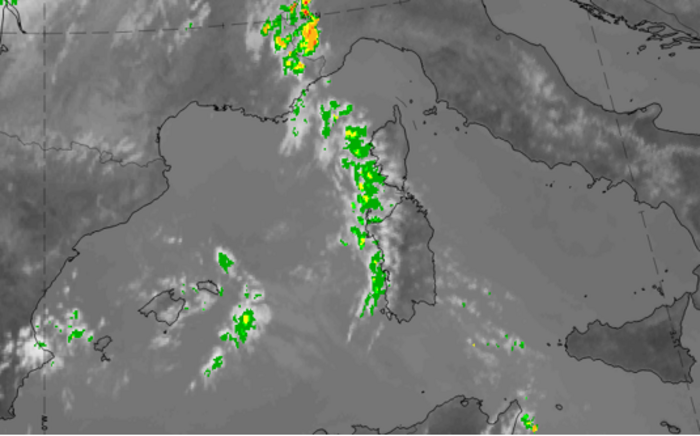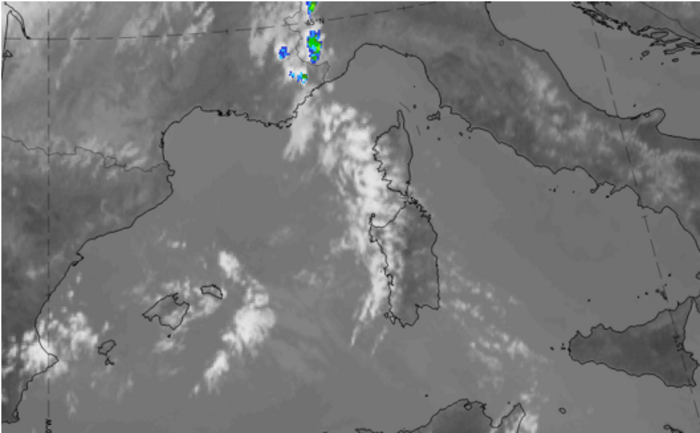Special investigation: Comma spirals in the Mediterranean
Introduction and problem
Commas are mesoscale cloud spirals; they usually develop in the cold air behind large-scale frontal systems, within an upper-level trough. Their dynamical background is typically characterised by anomalies in numerical parameters such as CVA (Cyclonic Vorticity Advection), often in the left exit region of a jet streak, and PV (Potential Vorticity) . They are mostly very active cloud systems.
These weather systems occur from time to time over the Mediterranean, with intensive cold fronts, representing the polar front, and comma cloud spirals behind. An example of this is shown in the image below from 02 March 2020 at 12:00 UTC. The cold front cloudiness stretches from the Alps southward to northern Africa. The comma is close behind, extending from the Pyrenees to the Balearic Islands.
However, these situations occur relatively rarely. In many more cases mesoscale cloud spirals without any frontal cloud band in front of them can be observed in the Mediterranean area.
The case below from 14 November 2020 at 12:00 UTC shows two such spirals, one over Italy and Sardinia and one over western Turkey and the Aegean Sea.
Even more cases show mesoscale cloud spirals with mostly weak spiral heads and rather thin clouds, as can be seen over northern Africa (Tunisia and Morocco) in the image below from 25 May 2020 at 12:00 UTC.
This special investigation seeks answers to two questions:
- Do the Mediterranean cloud spirals really correspond to the "Comma" Conceptual Model (CM)?
- A typical cloud configuration in satellite images is only then a representative of a special CM if a typical physical-theoretical background also exists and is the driving force for the development of the cloud configuration.
- Are the weaker comma cloud spirals a result of a different or even a new CM?
To answer these, all mesoscale cloud spirals observed in the Mediterranean in one year (2020) have been investigated using satellite images and model parameters.
The criteria for the selection of a cloud spiral being included in this study were:
- A spiral form, even if the spiral is weak.
- A size between approximately 200 and 600 km.
- The cloud spiral should not be accompanied by a substantial large-scale Thermal Front Parameter (TFP): this means that there should not be any large-scale frontal conditions.
For the year 2020, 145 mesoscale spirals similar to commas were detected and evaluated. During the investigation process this was somewhat reduced so that in the end 120 cases were under consideration.
Investigation of numerical parameters for the selected commas
In the first investigation step, the structure of the comma cloud feature in terms of the following basic numerical parameters is determined:
- the upper-level (300-hPa) height: the configuration and scale of the height contours is determined;
- the relative position of the classical polar front: to distinguish between comma spirals being cold or warm air phenomena.
- the low-level (950-hPa) height: configurations of height contours are evaluated in respect to a strong or weak low or a flat distribution close to the surface. This provides some information about the thickness of the detected weather system in connection with the comma cloud;
- all numerical parameters essential for the CM "comma": CVA, PV, omega (vertical speed in pressure coordinates) and humidity, on levels and in vertical cross sections.
In the second step, the following basic and derived numerical parameters are investigated:
Categorisation of comma clouds in terms of typical configurations of upper-level (300-hPa) height contours
In this first investigations step, the configuration of typical "weather systems" (typical configurations of height contours) in upper levels are investigated. The scales of the upper-level height systems are also categorised into synoptic, meso- and small scales.
| Comma type | Typical Upper-level height contour configuration | Number of cases in 2020 (out of 145) |
| 1 | Upper-level troughs behind fronts (classical situation) | 15 (10 %) |
| 2 | Synoptic-scale upper-level troughs | 32 (22%) |
| 3 | Cut off lows | 44 (30 %) |
| 4 | Small-scale upper-level troughs within a cutoff low | 6 (4 %) |
| 5 | Small-scale upper-level troughs within a zonal stream | 25 (17%) |
| 6 | Small-scale secondary cutoff lows within large-scale cut off lows | 11 (12%) |
| 7 | Split off from large-scale occlusion spirals (classical situations) | 6 (4%) |
| 8 | CAD (cold air development)-like | 2 (1%) |
| 9 | Instant-occlusion-like | 4 (2%) |
Nine different types of upper-level height configurations were identified, with very large variability in frequency of occurrence.
Examples of the most important types in the table above are provided below. Each IR image is superimposed by 300-hPa height contours.
Schematics of upper-level height contour configurations for the most important comma types are shown below.
Schematic of 6 comma types in terms of upper-level height configurations.
From the table above and the examples some of these comma types can be summarized as follows:
The types 1, 2, 3 and 7 represent the classical configurations of commas in synoptic scale upper-level environments, such as troughs behind cold fronts or cutoff lows.
A second group can be summarized as follows:
The types 4, 5 and 6 represent comma spirals in connection with small-scale upper-level features which are also mainly troughs or cut off lows but at distinctly smaller scales, embedded within the synoptic scales mentioned above.
The types 8 (CAD-like) and 9 (instant-occlusion-like) represent cases which are similar to typical developments in connection with commas, but as they represent a very small number of cases, they are not discussed further in this study.
Locations of commas in the Mediterranean relative to the classical polar front
Classical commas are cold air phenomena; they appear behind the polar front, in cold air. For the commas diagnosed in the Mediterranean the question is whether they develop in the cold air behind the polar front or in the warm air ahead of it, and how this relates to the upper-level height types analysed before.
To identify the polar fronts, the main source used was the "Weerkaarten archif Europa" from KNMI. This was supported by using Air Mass RGBs, which were inspected in respect to the green, blue and brown colours representing warmer, colder and dry air, respectively.
The case from 02 March is described above as being an example of a classical comma situation, and this investigation step provides evidence to support this classification. A polar front accompanies the broad frontal cloud band in the western Mediterranean and the comma cloud behind it is, according to the Airmass RGB, in cold and very dry air.
Both commas occurring on 14 November, the western one over Corsica and Sardinia representing Type 5 and the eastern one over western Turkey and the Aegean Sea representing type 3, are located far ahead of the main polar front, which extends from the Atlantic to western Europe. They are therefore, according to the usual interpretation, in warm air. However, as can be seen from the previous part of the investigation, they are also in connection with a cutoff low and a trough in upper levels; these are either remnants of previous systems or small-scale developments (or both).
The small-scale comma over Tunisia and Algeria seen on 25 May, representing comma type 4, is far ahead of the polar front (which extends from the western Atlantic northward to Iceland) but nevertheless within a band of colder air represented by the blue colour in the Airmass RGB. As is shown before, the comma cloud is in front of a small-scale upper-level trough.
From these examples and all the other cases that were investigated, it can be concluded that the overwhelming majority of comma configurations in the Mediterranean are situated ahead of the main polar front. This means on the one hand that they are in warm air (compared to the cold air outbreaks behind the polar front) but on the other hand that there are indeed upper-level weather systems in the Mediterranean ahead of the polar front. Those weather systems are mainly reflected by lows and troughs in upper levels and can appear on different scales:
Synoptic-scale:
These are mostly upper-level troughs or cutoff lows from older systems which reach from the north into the Mediterranean;
Mesoscale:
Mostly cutoff lows located in the Mediterranean;
Small-scale:
Developing within larger scale weather systems reaching from the north into the Mediterranean or within a zonal stream of geopotential.
Up to here only the height configurations in upper levels and the location relative to the polar front have been investigated. The next investigation step focuses on comma configurations ahead of the main polar front.
Combination of results from the first investigation step with lower-level (900-hPa) height contour configurations and scales
In the next step, the height configurations very close to the surface are evaluated; this can be used along with the upper-level heights to define the thickness of the weather system. The systems are separated according to lower-level height into the categories "distinct lows", "weak lows" and "flat distribution".
Combining all the information gathered so far and concentrating on commas ahead of the main polar front, the number of Mediterranean comma categories can be reduced from the 9 types, based only on upper-level contour features, to 3 classes, based on upper and low-level contour features as well as distance ahead of the main polar front.
Class 1:
Represents commas ahead of the polar front but in relation to synoptic or meso-scale weather systems in a thick layer. This class contains mainly types 1, 2 and 3 and corresponds to 37 cases.
Class 2:
Represents commas ahead of the polar front but in relation to synoptic or meso-scale weather systems only in high levels. This class contains mainly types 2 and 3 and corresponds to 29 cases.
Class 3:
Represents commas ahead of the polar front in relation to small-scale weather systems only in high levels. This class contains mainly types 4, 5 and 6 and corresponds to 28 cases.
Summary of typical characteristics of the three main classes of commas in the Mediterranean
| Class 1 | Class 2 | Class 3 | ||||
| Relative location | In the warm air ahead of the main polar front | |||||
| Upper level |
|
|
|
|||
| Lower level |
|
|
|
|||
Typical weather events which can be expected for the classical comma situation and commas belonging to classes 1, 2 and 3
Commas of the classical type, behind the polar front in cold air, are usually very active meteorologically. There is upward motion, cyclonic vorticity advection and instability, leading to the possibility of heavy rain and thunderstorms. But is this also true for the Mediterranean commas treated in this investigation? And are there differences between the three classes 1, 2 and 3 that occur ahead of the polar front?
All cases were investigated using weather observations, the European radar system OPERA and the Nowcasting SAF products Precipitating Clouds (PC) and Convective Rainfall Rate (CRR). However, these materials were not available for all cases for two reasons: firstly, commas on meso- and small scales can have cloud configurations located entirely over ocean areas where no synoptic stations are available and secondly, OPERA does not exist in the more eastern and the southern parts of the Mediterranean. Nowcasting SAF parameters do not have these geographic restrictions but are of course of lower quality. Further has to be taken into account that types or classes of the Mediterranean commas cannot be compared easily if they occur in different seasons.
Having taken these restrictions into account, the commas presented here and below are reliable representative examples.
In this subchapter the typical weather situation for the type 1 commas, those in a classical environment behind a polar front, is first demonstrated. A case from 18 September 2020 at 12 UTC was chosen because in the case of 02 March 2020 at 12 UTC, studied the first chapter, the comma is located exactly over the Gulf of Lyon where no weather measurements are available.
18 September 2020, 12 UTC; type 1 classical comma environment behind a polar front
u.l.: IR + synoptic reports; u.r.: IR + synoptic reports + radar from OPERA; l.l.: IR + PC (precipitating clouds) + CRR (convective rainfall rate)
The cold front clouds are to the east of Spain and the comma behind lies directly over Spain (there are two commas but we concentrate here on the eastern one).
Cb (cumulonimbus) and shower reports can be seen from available stations and the radar, PC and CRR values are all very high. Therefore, this example reflects the expected high meteorological activity characteristic of a classical comma.
Investigations of complete Set of key parameter sets for the representatives of the three classes
Individual case studies from each of the three classes were investigated, looking at all the key parameters described in the Conceptual Model "Comma", including height contours, vorticity advection and PV, both on horizontal surfaces and in vertical cross sections.
A case from class 1
Class 1 represents commas ahead of the polar front but in relation to synoptic or meso-scale weather systems in a thick layer. It contains mainly types 1, 2 and 3; 37 cases were found in the investigation for 2020 described above.
The case for class 1 case shown here is from 27 April 2020 at 15 UTC and represents type 3 – a comma within a synoptic scale upper-level trough.
27 April 2020/ 15 UTC; type 2 comma
u.l.: 300-hpa height contours and VCS (vertical cross section) line; u.r.: TFP (thermal front parameter); l.l.: Contours of CVA (cyclonic vorticity advection) 300-hPa; l.r.: Contours of height at which PV = 2 units
27 April 2020, 18 UTC;
Fronts, trough lines, convection lines, High and Low centres;
The red line at the east coast of Spain indicates a convection line connected to the comma.
The main polar front is located far to the west over the Atlantic
27 April 2020, 15 UTC; class 1 comma
u.l.: IR + synoptic reports; u.r.: IR + synoptic reports + radar from OPERA; l.l.: IR + PC (precipitating clouds) + CRR (convective rainfall rate)
The weather situation in this case is representative of the class 1 cases: these commas are generally meteorologically active and, in many cases, Cbs, showers, thunderstorms and rain of varying intensity are contained in the comma cloud.
The case from 27 April 2020 at 15 UTC shows a very distinct and meteorologically active comma spiral over Spain, which appears at the leading side of a synoptic scale trough and a very weak low-level trough. According to the TFP it does not have the character and dimensions of a frontal system. It is connected to a distinct maximum in CVA of and shows a PV anomaly at its rear side. This is reflected very clearly in the vertical cross sections, with a large downward-inclined zone of strong isentrope gradients. This "crowding zone" can be detected from about 350 hPa down to 800 hPa. The maximum in cyclonic vorticity at high levels is very strong and in front of an emerging PV anomaly. At middle and high levels, the omega field indicates upward motion.
From investigating all cases of this class, the schematic below summarizes the most important qualities, it can be concluded that for the class 1 the comma cloud spiral is mostly very distinct and develops behind a frontal system or within upper-level troughs or cutoff lows. Those fronts and weather systems do not represent the actual polar front but rather old systems. They are connected to a downward-inclined crowding zone of isentropes, which starts below the tropopause and reaches into middle and even low levels. If a class 1 comma develops behind a cold front cloud band, two downward-inclined zones can also be observed in the vertical cross section, belonging to the front and to the comma. In most cases there is a PV anomaly below the crowding zone, and maxima in CVA, upward motion and humidity do occur.
A case from class 2
Class 2 represents commas ahead of the polar front but in relation to synoptic or mesoscale weather systems only in high levels. This class contains mainly types 2 and 3; 29 cases were found in the investigation for 2020.
The class 2 case shown here is from 25 July 2020 at 21 UTC and is situated in a mesoscale cutoff low.
25 July 2020, 21 UTC; type 3
u.l.: 300-hPa height contours and VCS line; u.r.: TFP and 950-hPa height; l.l.: height contours of CVA 300-hPa; l.r.: contours of height at which PV = 2 units
25 July 2020, 18 UTC;
Fronts, trough lines, convection lines, High and Low centres;
The red curved line over the Balkan Peninsula indicates a convection line connected to the comma.
The main polar front is located from the Atlantic northeastward to western and northern Europe
25 July 2020, 21 UTC: Horizontal cross sections, type 3
left: isentropes and PV > 1 unit; right: isentropes and vorticity advection: anticyclonic in blue and cyclonic in red
25 July 2020, 21 UTC; class 2
u.l.: IR + synoptic reports; u.r.: IR + synoptic reports + radar from OPERA; l.l.: IR + PC (precipitating clouds) + CRR (convective rainfall rate)
This class 2 case also includes very active weather events. In nearly all cases investigated of this class, there were showers, Cbs and sometimes also thunderstorms reported.
Based on the cases shown here for classes 1 and 2, then, no clear difference in weather activity can be seen compared with a classical comma. In particular, it cannot be definitely stated that class 1 or class 2 commas are less meteorologically active.
The case from 25 July 2020 at 21 UTC shows an intensive comma spiral over the Balkan Peninsula which is very active. It is on the leading side of what is a deep upper-level trough or already a cutoff low. However, there are no continuous frontal features, as can be seen from the TFP, and the geopotential lines close to the surface have a very flat distribution. This is typical for a comma belonging to the class 2. At 300 hPa there is only a weak maximum in cyclonic vorticity advection but a distinct PV anomaly behind the comma cloud. In the vertical cross sections, the most striking feature is instability reaching very high levels. Above this unstable column there is a downward-inclined zone of isentropes between about 300 and 550 hPa, which is also accompanied by a PV anomaly below the inclined isolines and a maximum of CVA which is much stronger, as could be seen on the 300 hPa level alone. This comma configuration is therefore accompanied by most of the important key parameters features of a comma in the highest zone of the troposphere.
A schematic summary of the qualities of key parameters for the "class 2" is shown below.
As in class 1, in class 2 the comma configurations are distinct and appear in connection with upper-level troughs or cutoff lows at synoptic- or mesoscales; but in contrast to class 1, there is only a flat distribution of height contours at low levels, meaning that it is only an upper-level system.
There are two sub-groups of environments which can best be seen in the vertical cross sections: one sub-group is accompanied by a rather thin downward-inclined crowding zone from below the tropopause reaching into mid-levels; another subgroup has a very low tropopause and the downward-inclined crowding zone only occurs in a shallow layer. Examples of these two subgroups can be seen in a chapter after the end of this investigation, which contains a selection of more cases. (under construction)
A case from class 3
Class 3 represents commas ahead of the polar front in relation to small-scale weather systems only at high levels. This class contains mainly types 4, 5 and 6; 28 cases were identified for 2020.
The examples of this class are the most interesting as they are accompanied by weak comma spirals and therefore it can be called into question whether they belong to the CM "comma".
In this investigation a case from 27 June has been chosen as an example of class 3.
27 June 2020/ 12 UTC; type 5
u.l.: 300-hPa height contours and VCS line; u.r.:TFP and 950-hPa height;; l.l.: CVA units 300 hPa; l.r.: contours of height at which PV = 2 units
27 June 2020, 12 UTC;
Fronts, trough lines, convection lines, High and Low centres;
The main polar front is located over the Atlantic extending to western Europe.
27 June 2020, 12 UTC; type 5
left: isentropes and PV > 1 unit, right: isentropes and vorticity advection: anticyclones in blue and cyclonesin red
27 June 2020, 12 UTC; class 3
u.l.: IR + synoptic reports; u.r.: IR + synoptic reports + radar from OPERA; l.l.: IR + PC (precipitating clouds) + CRR (convective rainfall rate)
Class 3 commas differ distinctly from those of classes 1 and 2 as they contain (including for the case detailed here) cumulus cloud, very often superimposed with high cloud. Mostly no rain or rain showers are reported, however, there is some probability of rain and one or two light rain reports can be seen in some cases of this class.
The case from 27 June 2020 at 12 UTC is typical of comma cloud spirals that are rather small-scale and involve of less intensive cloud and weather events. Nevertheless, they occur in front of a small-scale upper-level trough, which is reflected in cyclonic vorticity advection and a weak PV anomaly. This can be seen much more clearly in the vertical cross sections.with a small scale downward inclined zone between 300 and 400-hPa as well as a PV anomaly, with the PV=2 line bending downward below the tropopause; there is also a weak maximum of cyclonic vorticity advection larger than 2 units in this layer.
Summarising these key parameter features, it can be concluded that this example of a class 3 comma does follow the behaviour of the most important key parameters for the CM "Comma" and can therefore be classified as such.
A schematic summary of the key parameters for class 3 is shown below.
The main difference compared to classes 1 and 2 is the small scale of the upper-level height configuration: in the vertical cross section the downward-inclined zone of isentropes connected to a PV anomaly is immediately below the tropopause and rather thin. The PV anomaly is also right below the tropopause but the strengths of the CVA maxima at those heights connected to the cloud spiral of the comma can vary in intensity; usually they are stronger for small-scale upper-level cutoff systems than for small-scale upper-level troughs.
Summary
- In the Mediterranean classical comma configurations occur within the cold air behind the polar front. However, they form the minority of comma configurations, with only 10% of all comma events (in an investigation over the Mediterranean for the year 2020) in this category.
- Therefore about 90 % of Mediterranean mesoscale cloud spirals occur within a warm airmass ahead of or far away from the classical polar front.
- All these commas are related to low-pressure systems at high levels but on very different scales and configurations; they can be divided in 6 types.
- These upper-level height systems are either the remnants of older weather systems or develop directly within upper-level troughs, cutoff lows or the zonal stream ahead of the main polar front.
- Based on the height configurations at low levels the commas can be divided into three classes according to scale and thickness of the system:
- Class 1 are distinct and large commas in synoptic- to mesoscale environments in upper and lower levels;
- Class 2 are also in a synoptic- or (more often) in mesoscale upper-level environments; the height contours follow a flat distribution in low levels;
- Class 3 are small-scale commas consisting of weak clouds in synoptic-scale environments only in upper levels, while the low levels are flat.
- Evaluating the typical key numerical parameters of the Conceptual Model "Comma" shows that the Mediterranean commas have corresponding for at least the most important dynamic parameters and therefore belong to this conceptual model.
- The group of small and less meteorologically active comma configurations (class 3), for which there was the largest doubt as to whether they are indeed "Comma"s, show typical "Comma" configurations of the key parameters CVA and PV only in high levels close to the tropopause.
- A deeper investigation of the weather features within the comma configuration shows (apart from differences in weather based on commas in different seasons, localities and times of day) that class 1 and 2 commas can be accompanied by intense weather events including thunderstorms and heavy rain, making them similar to active classical commas. Class 3, however, is different in that it is associated mostly with cumulus cloud accompanied by high cloud above, and no intense weather events would be expected to occur, although for these cases the occurrence of isolated rain events cannot be excluded.
If you are interested in more cases for you own investigation, please click on the button below:

















